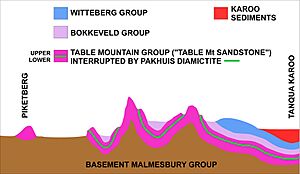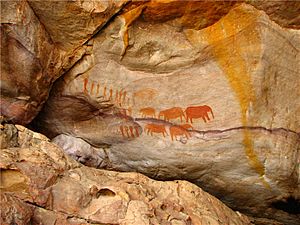Cederberg facts for kids
Quick facts for kids Cederberg Wilderness Area |
|
|---|---|

Sneeuberg, the highest peak in the Cederberg, with the Maltese Cross in the foreground.
|
|
| Location | West Coast, Western Cape, South Africa |
| Nearest city | Clanwilliam |
| Area | 710 km2 (270 sq mi) |
| Established | 1973 |
| Governing body | CapeNature |
| World Heritage site | 2004 (Cape Floral Region Protected Areas) |
The Cederberg mountains are a special place in South Africa, about 300 kilometers north of Cape Town. They are close to the town of Clanwilliam. These mountains get their name from a rare tree called the Clanwilliam cedar. This tree grows only in this area. The Cederberg is famous for its amazing rock shapes and ancient San rock art. CapeNature looks after the Cederberg Wilderness Area.
The name Cederberg is now the most common way to spell it. It mixes the English word "Cedarberg" and the Afrikaans word "Sederberg".
Contents
Geography and Climate in Cederberg
The Cederberg mountains stretch about 50 kilometers from north to south and 20 kilometers from east to west. Nearby towns include Citrusdal and Clanwilliam. Not many people live in this area.
There are some very tall mountains here, like Sneeuberg (2026 meters high) and Tafelberg (1969 meters high). Don't mix up this Tafelberg with the famous Table Mountain in Cape Town! The Cederberg also has cool landmarks like the Maltese Cross, Wolfberg Arch, and Wolfberg Cracks.
The mountains are mostly made of reddish sandstone rocks. These rocks are part of the Cape Fold Belt, just like Table Mountain. Scientists have found old fossils of early fish in these rocks. These fossils are about 450 million years old!
Summers in the Cederberg are very hot and dry. Winters are colder and get more rain. The highest peaks sometimes get a light dusting of snow in winter. Most summer days have clear, sunny skies. Because the skies are so clear, it's a great spot for stargazing. There's even a small observatory here.
Plants and Animals of Cederberg
The main type of plant life here is fynbos, especially in the wetter southern and western parts. As you go north and east, it changes to plants that like dry, desert-like areas. The rare Clanwilliam cedar tree and the snow protea flower only grow in these mountains. You can find them high up in the remote areas.
The Cederberg is home to amazing animals. Big cats like the leopard and caracal live here. You might also see rock hyraxes (also called "dassies"), meerkats, and other mongooses. Larger animals include different kinds of antelopes, and the vulnerable Cape mountain zebra. Chacma baboons are also common. Many birds, small mammals, reptiles, and insects live here too.
Some special fish also live in the Cederberg rivers. These include the Clanwilliam yellowfish, Clanwilliam redfin, and sawfin. These fish are considered vulnerable or endangered.
Human Activities in Cederberg
History of the Cederberg
Many caves and rock overhangs in the Cederberg have ancient San rock art. These paintings show that early people lived here a long time ago. When Europeans arrived, they started farming and cutting down trees. Many thousands of local cedar trees were cut down for things like telephone poles and furniture.
In the northern part of the Cederberg, there's an old mission station called Wupperthal. It's a small farming community. They are known for making velskoene, which are traditional soft leather shoes.
Farming in the Cederberg
Farming is not easy in the Cederberg because of the high altitude, dry weather, and rocky ground. But some farms do exist. Rooibos tea is the most famous product from this area. Some farms also grow fruit and tobacco. The Cederberg even has South Africa's highest winery. There are also some small farms around Wupperthal where people grow food for themselves. Some farms now welcome visitors as guest farms.
Tourism and Fun in Cederberg
The Cederberg Wilderness Area is a great place for eco-tourism. Many people come here for camping, rock climbing, and hiking. Algeria is the main campsite, run by CapeNature. Other campsites like Sanddrif, Driehoek, Jamaka, and Kromrivier are privately owned.
The Cederberg is famous for its excellent rock climbing routes, especially around Krakadouw and Tafelberg peaks. The sandstone rocks are perfect for amazing climbs. There are many hikes you can do, from short day trips to overnight adventures. Popular hikes include the Wolfberg Arch, Wolfberg Cracks, and the Maltese Cross.
The area also has an amateur astronomical observatory. They often have open evenings where the public can come and look at the stars. You can also find various 4x4 routes for off-road driving.
The charming village of Wupperthal is part of a mission station route. It gives visitors a look into rural life and is known for its handmade leather shoes. There's also a project developing a donkey cart trail from the Pakhuis Pass to a small village called Heuningvlei.
Scouting Adventures
The Cederberg is also where the Senior Scout Adventure takes place. This is a 12-day event for Scouts from Scouts South Africa, held every two years.
Images for kids





